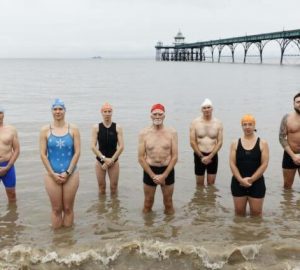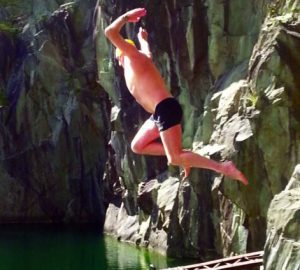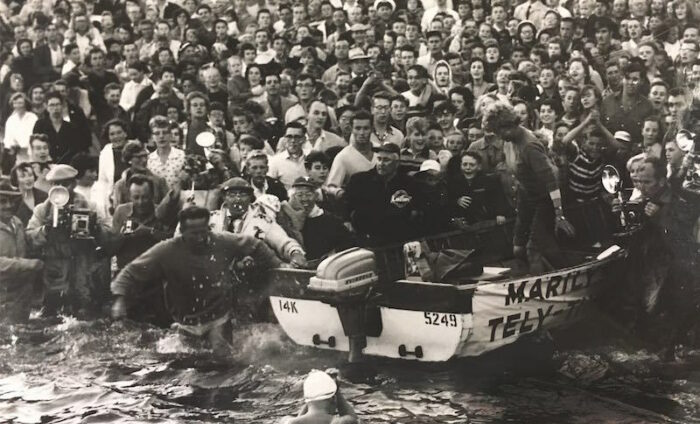
Strait of Juan de Fuca
Bert Thomas accepted the challenge of marathon swimming and inspired a tradition that continues today By Elaine K Howley
The 1950s in America signalled a time of great hope and prosperity. Upon the conclusion of the Second World War, things were looking up in the most industrialised nation in the world, buoyed as it was by victory on the global stage and a roaring, war-infused economy. It was a time of promise and change, when the impossible was nothing. Perhaps it was that same sense of being able to triumph over all that created the right environment for marathon swimming to flourish.
Spurred on by the likes of Florence Chadwick, Marilyn Bell and Greta Andersen, and lured by the promise of a “quick” buck in some cases – newspapers of the era were flush with cash and spending it freely to sponsor swimmers and races around the country –male swimmers jumped into the fray and churned their way across a myriad of waterways. But for whatever reason, many of them have been forgotten. In a rare instance of the lasting impression of female empowerment, the ladies of marathon swimming in the 1950s and 1960s are in many cases more recognisable household names today than their male counterparts.
Personally, if I’m being honest about my feminist sensibilities, I find this a little bit gratifying. But only to the point where my embrace of girl power rubs up against my desire to see every worthy marathon swimmer recognised for honest achievements. Although I’m pleased that the mid-century women of marathon swimming are relatively well known, their male colleagues also accomplished some incredible feats. One of them even sparked a marathon swimming tradition in a whole region that carries on in robust fashion today: Bert Thomas.
The Bert Thomas story
In 1948 at just 23 years old, Thomas had already spent six years in the navy as a frogman and had fought in the Pacific Theatre in World War II. His service to his country concluded, Thomas returned to his hometown of Tacoma, Washington, on Puget Sound and took up logging and longshoring to make ends meet. In 1950 and 1951 press coverage of Florence Chadwick’s record-setting feats in the English Channel travelled to the Pacific Northwest and caught the attention of local newspapers interested in bringing the famous swimmer to the shores of their town. These reports also intrigued Thomas, a formidable swimmer and giant of a man who feared no cold water.
Hoping to capitalise on Chadwick’s “Channel Fever” sweeping North America, in 1954, The Victoria Daily News in British Columbia announced it would offer her $7,500 just for attempting to swim the Strait of Juan de Fuca, a treacherous 18.3-mile stretch of very cold water that separates the American state of Washington from British Columbia, Canada. That prize would be worth the equivalent of more than $66,000. But just for good measure, the paper offered an additional $2,500 bonus if she were successful in making the swim from Victoria to Port Angeles, Wash. for a potential total payout of $10,000 if she succeeded. Chadwick went for it in August 1954. managing about five hours in the 47-degree Fahrenheit (8.3 degrees Celsius) water.
Undeterred, the newspaper still wanted to see a swimmer make it all the way across, so made a blanket offer: $1,000 to the first person to succeed. The Port Angeles Chamber of Commerce and local businesses chipped in another $2,500.
Thomas decided this would be his meal ticket and in spring 1955, he set up a training headquarters at a hotel in Victoria. He trained daily and attempted to make the crossing at least four times, all without success. According to marathon swimming historian Conrad Wennerberg in his 1997 book, “Wind Waves and Sunburn: A Brief History of Marathon Swimming,” after these unsuccessful attempts, Thomas hit on two key adaptations that would make all the difference: gaining weight and going the opposite direction.
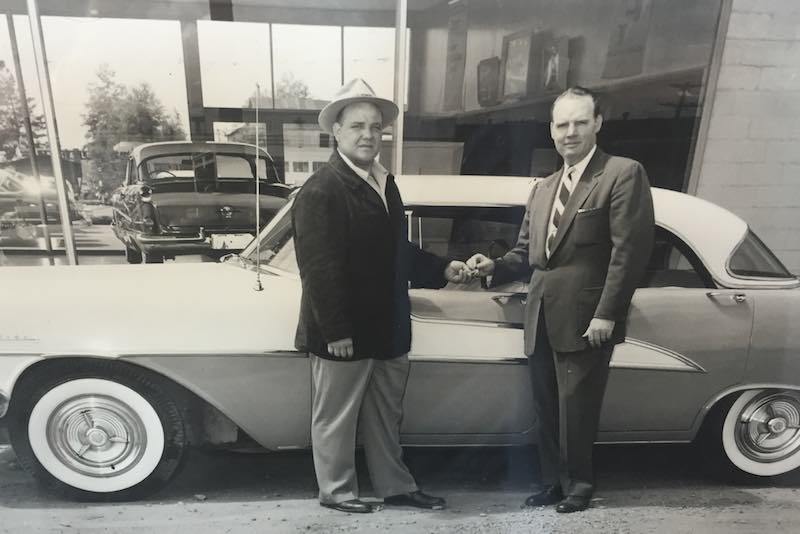
Bert Thomas (left)
“Thomas went home to his wife saying that the only thing that would beat the straits was fat. Over the winter Bert, with the help of his loving wife, who was also an excellent cook, had managed to add 40 pounds to his already huge six-foot-two-inch frame. On his last attempt he had weighed 230 pounds. In just a little over 10 days before his latest attempt Bert, putting Diamond Jim Brady to shame, added a further 10 pounds by consuming gallons of milk and pounds of steak, potatoes, bread and desserts. The 270-pound, barrel-chested American then had himself driven to Port Angeles on the American side. “To hell with leaving from Victoria….”
Although some sources say Thomas actually tried to make the crossing on 16 different occasions, his final attempt was a success on 8 July 1955. After 11 hours and 10 minutes of swimming in water reportedly 48 degrees Fahrenheit (8.9 degrees Celsius), he stepped onto Canadian soil.
This Herculean effort put Thomas and the Pacific Northwest on the marathon swimming world map, and the following summer, four swimmers made the crossing. Cliff Lumsdon led the 1956 charge, swimming from Canada to America in 11:35 on 17 August. Amy Hiland and Ben Laughren both swam from America to Canada on 18 August finishing in 10:51 and 10:17 respectively. Canada’s darling marathon swimmer Marilyn Bell, fresh off her success becoming the youngest swimmer to cross the English Channel earlier that summer, completed the crossing from America to Canada on her second attempt on 23 August in 10:38.
Of that swim, Bell says she undertook it 13 days after her first attempt because that failure, “weighed on me heavily. I went back and decided that instead of swimming from Victoria to Port Angeles, I wanted to swim home. I decided if I changed my direction I’d have a totally different mindset—‘I’m swimming home to Canada.’”
The day of the swim, the forecast wasn’t great, and her pilot cautioned her that it would probably end up being just a training swim, but she was resolute. “I remember saying to [Coach Gus Ryder] before I started, ‘Do not let me get out.’ I’ve never been more determined than I was that day. I had something to prove to me, not anybody else.”
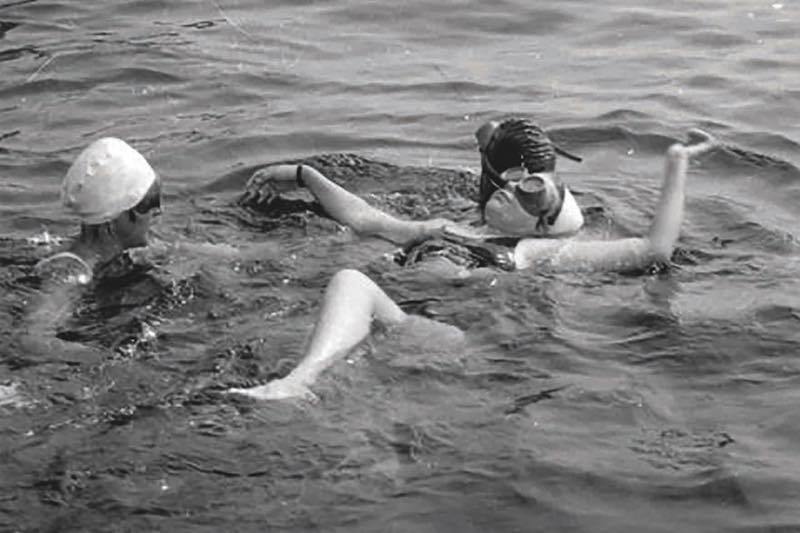
This image: Marilyn Bell is removed from the water on her first attempt to swim the Strait of Juan de Fuca in August 1956; main image, top: hundreds of spectators greeted Marilyn Bell as she completed the crossing
Bert rebooted
Bell’s swim was the last across the Strait for a very long time. Perhaps it was the difficulty of the swim or a lack of interest after that first rush of swimmers got across in the mid-1950s, but the Strait went dormant for more than 30 years. Finally, on 10 August 1989, Canadian legend Vicki Keith crossed from America to Canada in 14:01 using only the butterfly stroke. The only other person who’s successfully crossed the Strait is Andrew Malinak, a geotechnical engineer from Seattle, who swam from Canada to America. He crossed in a lightning fast 6:59 on 6 September 2015 during his “Summer of Bert” in which he paid homage to several of Thomas’s swimming feats.
Malinak’s “Summer of Bert” kicked off in nearby Puget Sound with a reverse of Thomas’s Seattle to Tacoma swim. Thomas had completed the 20-mile swim in 15:23 on 15 May 1956, and Malinak swam from Tacoma to Seattle on 6 June 2015 in 8:49. On 8 August 2015, Malinak completed a first-ever circumnavigation of Bainbridge Island, also in Puget Sound, even though Thomas hadn’t done that swim before. It was a training swim for the main event, his Strait of Juan de Fuca that would occur a month later.
Malinak says the “Summer of Bert” was meant to be a training summer for his second attempt at the Strait; his first attempt in 2014 was delayed by fog, which caused him to miss the tides. “I thought that I needed a few things to be ready to attempt the second time – I needed to be confident that I could plan my own swim and confident that I could swim the distance and comfortable with the cold. I was looking around for swims in the area that matched the temperature and distance, and quickly came across the idea that Bert Thomas was the first person to swim from just down the road from where we train [at Alki Beach in Seattle] to Tacoma, where we also sometimes train. The thought of duplicating two of his old swims, really struck Malinak, who’s a marathon swimming historian in his own right. Inspired by what Thomas had accomplished all those years ago, Malinak paid homage the best way he knew how: by swimming the historic routes.
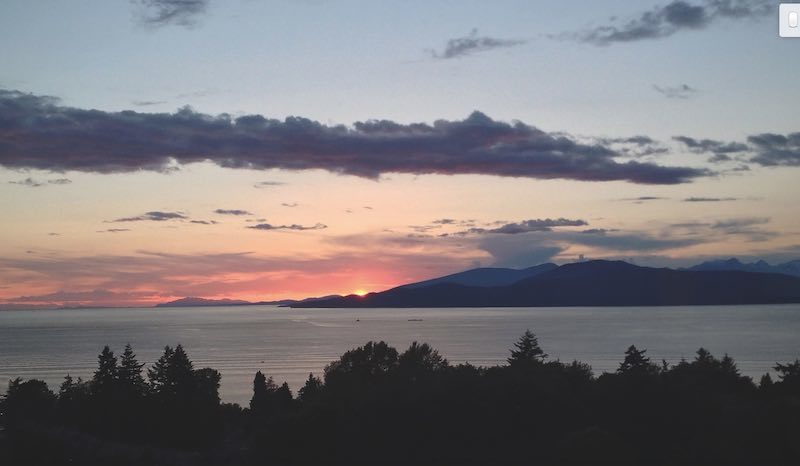
The sun sets on the water in British Columbia
The summer of 2015 was a great adventure for Malinak and a revival of swimming and bringing media attention to marathon swimming in the Pacific Northwest. In addition to renewing interest in historical swims in the region, Malinak also founded the Northwest Open Water Swimming Association (NOWSA) to sanction and observe swims in the Strait of Juan de Fuca, Puget Sound, Lake Washington and other waterways in the region. Malinak and his organisation have observed several “firsts,” including Wendy Van De Sompele’s around Vashon Island swim in August 2016 in Puget Sound and three swims around Mercer Island in Lake Washington also in 2016. Those swims served as test runs for NOWSA’s inaugural around Mercer Island Marathon Swim event slated for 2 June 2017.
In organising these events and curating the history of marathon swimming in the region, Malinak is connecting the past to the present and doing his part to make sure Bert Thomas’s memory doesn’t fade into the mists of time the way that so many others have. Thomas doesn’t deserve to become obscure, says Malinak: “He clearly wasn’t just the average swimmer that you’d know today. That’s what I thought was cool about him. He sounded like a legend, and not just a mere swimmer.”
Much the same could be ventured about Malinak, too, and perhaps one day, some 60-odd years from now, another adventurous marathon swimmer will stage a “Summer of Malinak.”
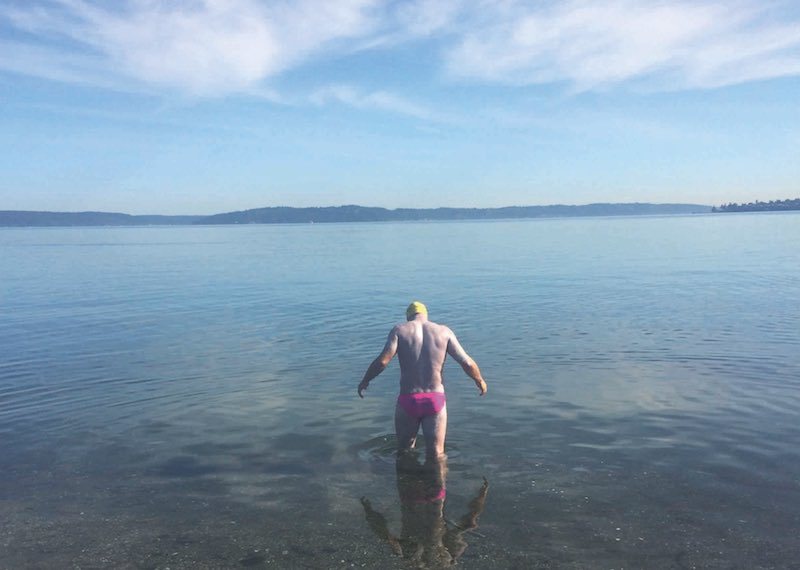
Andrew Malinak of Seattle wades into the water in Tacoma to begin an 18.8-mile swim back to Seattle in honour of Bert Thomas
Images: Courtesy of Marilyn Bell/Newspapers.com/Elaine K. Howley/ Pixabay/Howie Ruddell







